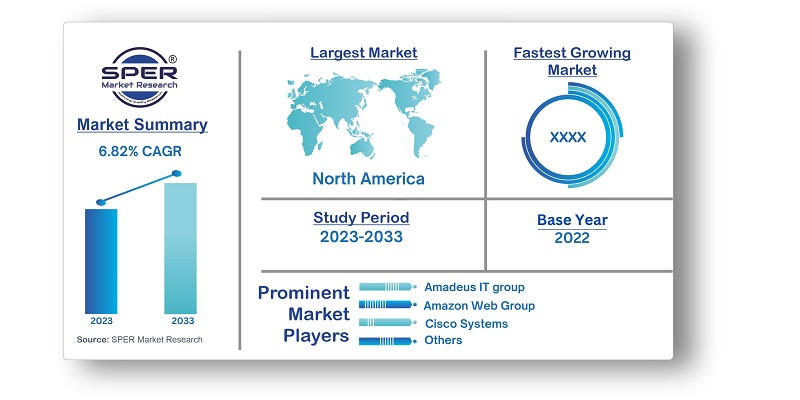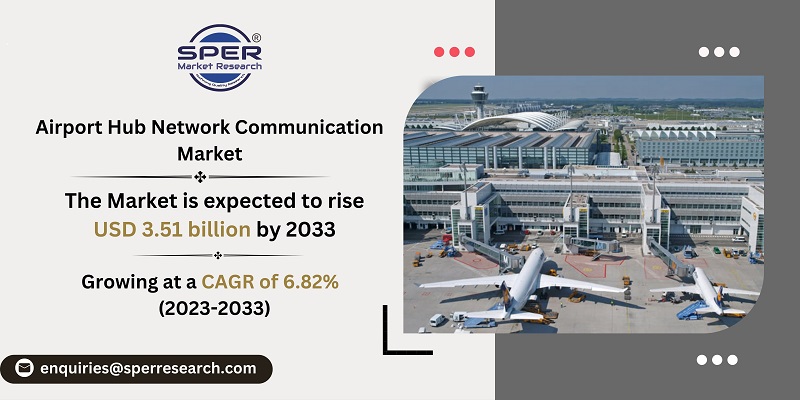
Airport Hub Network Communication Market Growth, Size, Trends, Challenges and Future Outlook
Airport Hub Network Communication Market Size- By Application, By Type, By Communication Technology- Regional Outlook, Competitive Strategies and Segment Forecast to 2033
| Published: Jul-2023 | Report ID: IACT23134 | Pages: 1 - 234 | Formats*: |
| Category : Information & Communications Technology | |||
- Increasing air travel: The global increase in air travel is a major driver for the Airport Hub Network Communication industry. As more people and airlines use airport hubs, the requirement for robust and dependable network communication infrastructure to handle the increasing volume of data, phone, and video traffic grows.
- Focusing on safety and security: Security and safety measures are a top priority for airports. Effective surveillance, access control, and emergency response systems depend on network communication networks. There is a rising need for cutting-edge communication solutions that can fulfil these requirements as airports concentrate on upgrading security measures.


| Report Metric | Details |
| Market size available for years | 2019-2033 |
| Base year considered | 2022 |
| Forecast period | 2023-2033 |
| Segments covered | By Application, By Type, By Communication Technology. |
| Regions covered | Asia-Pacific, Europe, Middle East and Africa, North America, Latin America |
| Companies Covered | Amadeus IT group, Amazon Web Group, Cisco Systems, Collins Aerospace, Embross Systems, Honeywell, SITA Switzerland, TAV Technologies, Others. |
- Airport Operators and Authorities
- Airlines and Airline Ground Handlers
- Telecommunication Service Providers
- Systems Integrators and Solution Providers
| By Application : |
|
| By Type : |
|
| By Communication Technology : |
|
- Global Airport Hub Network Communication Market Size (FY’2023-FY’2033)
- Overview of Global Airport Hub Network Communication Market
- Segmentation of Global Airport Hub Network Communication Market By Application (Baggage Handling, Passenger Information Systems, Security and Surveillance)
- Segmentation of Global Airport Hub Network Communication Market By Type (Internet, MPLS)
- Segmentation of Global Airport Hub Network Communication Market By Communication Technology (Cellular, Wired, Wireless)
- Statistical Snap of Global Airport Hub Network Communication Market
- Expansion Analysis of Global Airport Hub Network Communication Market
- Problems and Obstacles in Global Airport Hub Network Communication Market
- Competitive Landscape in the Global Airport Hub Network Communication Market
- Effects of COVID-19 and demonetization on Global Airport Hub Network Communication Market
- Details on Current Investment in Global Airport Hub Network Communication Market
- Competitive Landscape of Global Airport Hub Network Communication Market
- Prominent Players in the Global Airport Hub Network Communication Market
- SWOT Analysis of Global Airport Hub Network Communication Market
- Global Airport Hub Network Communication Market Future Outlook and Projections (FY’2023-FY’2033)
- Recommendations from Analyst
1.1. Scope of the report1.2. Market segment analysis
2.1. Research data source2.1.1. Secondary Data2.1.2. Primary Data2.1.3. SPER’s internal database2.1.4. Premium insight from KOL’s2.2. Market size estimation2.2.1. Top-down and Bottom-up approach2.3. Data triangulation
4.1. Driver, Restraint, Opportunity and Challenges analysis4.1.1. Drivers4.1.2. Restraints4.1.3. Opportunities4.1.4. Challenges4.2. COVID-19 Impacts of the Global Airport Hub Network Communication Market
5.1. SWOT Analysis5.1.1. Strengths5.1.2. Weaknesses5.1.3. Opportunities5.1.4. Threats5.2. PESTEL Analysis5.2.1. Political Landscape5.2.2. Economic Landscape5.2.3. Social Landscape5.2.4. Technological Landscape5.2.5. Environmental Landscape5.2.6. Legal Landscape5.3. PORTER’s Five Forces5.3.1. Bargaining power of suppliers5.3.2. Bargaining power of buyers5.3.3. Threat of Substitute5.3.4. Threat of new entrant5.3.5. Competitive rivalry5.4. Heat Map Analysis
6.1. Global Airport Hub Network Communication Market Manufacturing Base Distribution, Sales Area, Product Type6.2. Mergers & Acquisitions, Partnerships, Product Launch, and Collaboration in Global Airport Hub Network Communication Market
7.1. Global Airport Hub Network Communication Market Value Share and Forecast, By Application, 2023-20337.2. Baggage Handling7.3. Passenger Information Systems7.4. Security and Surveillance
8.1. Global Airport Hub Network Communication Market Value Share and Forecast, By Application, 2023-20338.2. Internet8.3. MPLS
9.1. Global Airport Hub Network Communication Market Value Share and Forecast, By Communication Technology, 2023-20339.2. Cellular9.3. Wired9.4. Wireless
10.1. Global Airport Hub Network Communication Market Size and Market Share
11.1. Global Airport Hub Network Communication Market Size and Market Share By Application (2019-2026)11.2. Global Airport Hub Network Communication Market Size and Market Share By Application (2027-2033)
12.1. Global Airport Hub Network Communication Market Size and Market Share By Type (2019-2026)12.2. Global Airport Hub Network Communication Market Size and Market Share By Type (2027-2033)
13.1. Global Airport Hub Network Communication Market Size and Market Share By Communication Technology (2019-2026)13.2. Global Airport Hub Network Communication Market Size and Market Share By Communication Technology (2027-2033)
14.1. Global Airport Hub Network Communication Market Size and Market Share By Region (2019-2026)14.2. Global Airport Hub Network Communication Market Size and Market Share By Region (2027-2033)14.3. Asia-Pacific14.3.1. Australia14.3.2. China14.3.3. India14.3.4. Japan14.3.5. South Korea14.3.6. Rest of Asia-Pacific14.4. Europe14.4.1. France14.4.2. Germany14.4.3. Italy14.4.4. Spain14.4.5. United Kingdom14.4.6. Rest of Europe14.5. Middle East and Africa14.5.1. Kingdom of Saudi Arabia14.5.2. United Arab Emirates14.5.3. Rest of Middle East & Africa14.6. North America14.6.1. Canada14.6.2. Mexico14.6.3. United States14.7. Latin America14.7.1. Argentina14.7.2. Brazil14.7.3. Rest of Latin America
15.1. Amadeus IT Group15.1.1. Company details15.1.2. Financial outlook15.1.3. Product summary15.1.4. Recent developments15.2. Amazon Web Group15.2.1. Company details15.2.2. Financial outlook15.2.3. Product summary15.2.4. Recent developments15.3. Cisco Systems15.3.1. Company details15.3.2. Financial outlook15.3.3. Product summary15.3.4. Recent developments15.4. Collins Aerospace15.4.1. Company details15.4.2. Financial outlook15.4.3. Product summary15.4.4. Recent developments15.5. Embross Systems15.5.1. Company details15.5.2. Financial outlook15.5.3. Product summary15.5.4. Recent developments15.6. Honeywell15.6.1. Company details15.6.2. Financial outlook15.6.3. Product summary15.6.4. Recent developments15.7. SITA Switzerland15.7.1. Company details15.7.2. Financial outlook15.7.3. Product summary15.7.4. Recent developments15.8. TAV Technologies15.8.1. Company details15.8.2. Financial outlook15.8.3. Product summary15.8.4. Recent developments15.9. Others
SPER Market Research’s methodology uses great emphasis on primary research to ensure that the market intelligence insights are up to date, reliable and accurate. Primary interviews are done with players involved in each phase of a supply chain to analyze the market forecasting. The secondary research method is used to help you fully understand how the future markets and the spending patterns look likes.
The report is based on in-depth qualitative and quantitative analysis of the Product Market. The quantitative analysis involves the application of various projection and sampling techniques. The qualitative analysis involves primary interviews, surveys, and vendor briefings. The data gathered as a result of these processes are validated through experts opinion. Our research methodology entails an ideal mixture of primary and secondary initiatives.



Frequently Asked Questions About This Report
PLACE AN ORDER
Year End Discount
Sample Report
Pre-Purchase Inquiry
NEED CUSTOMIZATION?
Request CustomizationCALL OR EMAIL US
100% Secure Payment






Related Reports
Our Global Clients
Our data-driven insights have influenced the strategy of 200+ reputed companies across the globe.




















